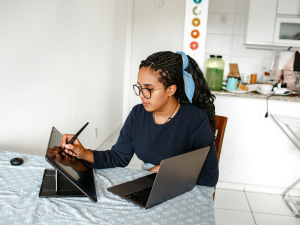Every semester, students across universities face the same problem: expensive textbooks that quickly become outdated. For many, these costs are more than just an inconvenience; they’re a barrier to learning. But a quiet shift is taking place on campuses around the world. Professors and students are no longer just using textbooks, they’re creating their own.
Welcome to the era of open educational resources (OER) , a growing movement where knowledge is shared freely, not sold. Instead of relying on costly, rigid textbooks, universities are building open-source materials that anyone can access, adapt, and improve. It’s a model built on collaboration, not commercial publishing.
Even more exciting is how students are now part of this process. They’re helping to write, review, and remix course materials alongside faculty, turning education into a creative partnership. The result? Learning that’s not only more affordable but also more relevant and dynamic.
Open-source textbooks are changing what it means to learn and teach, making knowledge a collective project instead of a product. The question is, how exactly does this collaboration work, and why are so many universities embracing it?
What Are Open Educational Resources (OER)?
Open Educational Resources, or OER, are learning materials that are free to use, share, and modify. They can include textbooks, lecture slides, videos, simulations, and even full courses all released under open licenses that allow anyone to adapt them. In short, OER replaces ownership with access.
Traditional textbooks are locked behind paywalls and copyright restrictions. Only publishers can decide when to update them, and every new edition means another round of expensive purchases for students. OER flips that model completely. Once a resource is created, it belongs to the learning community. Professors can revise chapters, students can add examples, and institutions can adapt it to local needs all without breaking copyright laws.
The concept is powered by the idea of “open pedagogy.” Instead of students passively reading from fixed materials, they participate in shaping them. It’s a teaching philosophy that values contribution over consumption giving learners a voice in what and how they study.
Many universities now use existing OER platforms such as OpenStax, OER Commons, and MIT OpenCourseWare to find or adapt open-source content. These repositories host thousands of textbooks and teaching tools that anyone can download and modify for free.
But OER isn’t just about access it’s about collaboration. The most impactful projects go beyond downloading materials. They bring students and professors together to build entirely new textbooks written in real classrooms, shaped by real learners.
This co-creation process is where open education starts to feel truly alive. Instead of teaching from someone else’s textbook, educators and students create knowledge side by side turning learning into a shared, evolving experience.
How Students and Faculty Co-Create OER
In most classrooms, students consume knowledge that’s already been packaged and printed. But in courses built around open educational resources, that model flips. Here, students aren’t just reading the material, they’re helping to create it.
This approach, often called open pedagogy, turns the classroom into a workshop for shared learning. Professors guide the structure, but students bring new perspectives, examples, and research that make the material richer and more relevant. Together, they build resources that other learners can use for years to come.
Writing and Creating New Content
Co-creation often begins with writing. A history class might divide into teams to write short case studies about local events. A biology group might draft new examples for a genetics module. Every contribution is reviewed, edited, and added to a growing textbook that reflects both the course goals and the students’ voices.
The result isn’t a polished publisher-style textbook, it’s something more personal. Students see their work referenced in lectures and cited in future semesters. That ownership changes how they learn. Instead of memorising information for an exam, they’re producing knowledge that others will rely on.
Reviewing and Editing Together
Quality matters, and peer review becomes part of the learning. Students read one another’s drafts, correct inaccuracies, and give feedback. Faculty members step in as editors, ensuring the content aligns with learning outcomes and academic standards. The process mirrors real-world publishing, collaborative, critical, and rewarding.
This shared editing builds confidence, too. Students learn how academic material takes shape and understand why evidence, clarity, and accuracy matter.
Curating and Remixing Existing Resources
Not all co-creation means starting from scratch. Many projects begin by curating existing OER, selecting the best chapters, videos, or exercises from platforms like OpenStax or OER Commons, then adapting them to fit the course.
This remix culture is what makes OER powerful. A psychology class in India can blend material from a U.S. textbook with examples rooted in local experience. A business course can rewrite global case studies to match emerging markets. Knowledge becomes flexible designed for context, not conformity.
Adding Interactive Elements
Today’s open textbooks go beyond static pages. Students often help build interactive components like short videos, digital quizzes, or infographics that explain complex topics in simpler ways. These multimedia additions make the learning experience more dynamic and give students a sense of creative contribution that traditional coursework rarely offers.
A Shift in Classroom Energy
When students and professors co-create, the dynamic changes. Class discussions feel more like collaboration than instruction. Students stop asking, “What’s on the test?” and start asking, “How can we explain this better for next year’s class?”
That shift builds something deeper than comprehension; it builds connection. Students see themselves as part of an academic community contributing to something larger than a single course.
Co-creation doesn’t just produce textbooks; it produces learners who understand how knowledge evolves, who value collaboration, and who leave the classroom knowing they’ve added something lasting to education itself.
Why Open Textbooks Work ; The Real Benefits
The open textbook movement isn’t just about saving money, it’s about rethinking what education can be when everyone gets to participate in creating it. From stronger learning outcomes to greater inclusion, the benefits go far beyond free access.
Better Learning Outcomes
Studies have shown that students who use open educational resources perform as well or better than those using traditional textbooks. The reason is simple: access. When materials are free from day one, no one has to wait for a paycheck or a used-book sale to start learning. Every student begins on equal ground, with the same resources at their fingertips.
But access isn’t the only factor. Because OER can be tailored to fit a specific class, the material feels more relevant. Professors can update examples, refine explanations, or include local case studies that help students connect theory with reality and that connection improves retention.
Higher Engagement and Ownership
When students co-create course content, they’re no longer just consuming information, they’re helping to shape it. That sense of ownership leads to stronger engagement. They read more carefully, write more thoughtfully, and collaborate more confidently because their work matters beyond a grade.
It’s the difference between completing an assignment and publishing one. Seeing your research or example cited in a future course gives the learning experience a new kind of weight. It’s proof that your voice contributes to the academic conversation.
Affordability and Equity
Textbook prices have soared over the past two decades, creating a hidden barrier to success. Some students skip buying required materials altogether, while others rely on outdated editions or shared copies. OER eliminates that problem entirely.
By removing cost from the equation, open textbooks make learning more equitable. Every student regardless of financial background gets immediate access to quality content. This not only reduces stress but also fosters a stronger sense of inclusion and fairness in the classroom.
Up-to-Date, Customisable Content
Traditional textbooks go through long publishing cycles, which means by the time they reach classrooms, much of the information is already dated. OER can be edited, expanded, or updated anytime.
If a major discovery is made in physics or a new policy changes business laws, the textbook can evolve overnight. Faculty members can add local context, emerging research, or new examples without waiting years for the next edition. That flexibility keeps education current and responsive to the world it reflects.
Faculty Growth and Collaboration
Open textbooks don’t just empower students, they challenge professors to teach in new ways. Creating OER encourages experimentation, collaboration, and digital literacy. Professors become facilitators of knowledge rather than gatekeepers.
Some universities, like Miami University and the University of Massachusetts Amherst, even recognise OER creation in tenure and promote an acknowledgment that building accessible knowledge is as valuable as publishing it.
A Shared Win for Everyone
The best part about OER is its ripple effect. Once created, these resources can be used and adapted by other institutions around the world. A textbook written by one class might help thousands of students elsewhere. It’s learning that multiplies not just within a classroom, but across borders.
At its core, open-source education turns learning into a shared act of generosity. Students gain skills, professors gain perspective, and future learners inherit better, freer materials.
The Challenges That Come With Openness
For all its promise, open education isn’t effortless. Building and maintaining high-quality open textbooks takes time, skill, and structure. While the benefits are clear, the path to achieving them comes with a few real-world challenges that universities and educators can’t ignore.
Time and Effort
Creating an open textbook is not as simple as uploading a PDF online. It’s a long process of writing, editing, verifying, and refining. Faculty and students must dedicate significant hours to researching, fact-checking, and formatting materials often on top of regular coursework or teaching loads.
Finding, reviewing, and adapting existing OER also requires careful evaluation to ensure accuracy and alignment with course objectives. Without institutional backing, the workload can easily overwhelm even the most enthusiastic educators.
Limited Institutional Support
Despite the growing popularity of OER, many faculty members still don’t receive formal recognition or compensation for their contributions. Unlike publishing through traditional academic channels, creating open textbooks doesn’t always count toward tenure or promotion.
To truly sustain OER, universities need to value and reward open scholarship. Grants, release time, or digital publishing support can make a significant difference in encouraging participation.
Quality Control
The open nature of OER means that anyone can publish materials, which can raise concerns about quality. Not all open resources go through rigorous peer review, and content accuracy can vary.
To address this, many institutions have started developing internal review boards or OER quality rubrics to ensure materials meet academic standards. When done right, openness doesn’t mean lowering quality, it means widening access to knowledge that’s still reliable and credible.
Copyright and Licensing Confusion
For newcomers, Creative Commons licensing can feel like a maze. Knowing what can be reused, remixed, or distributed isn’t always straightforward, especially when blending materials from different sources.
Universities can help by offering copyright training or providing OER specialists who guide faculty and students through the process. The goal is to keep openness simple, transparent, and legally sound.
Sustainability
Many OER projects start strong with grant funding but struggle to maintain momentum once the initial support runs out. Regular updates, platform maintenance, and content revisions all require ongoing investment.
To stay sustainable, institutions must view OER not as a one-time project but as a continuous commitment. Building long-term funding models through library partnerships, faculty stipends, or collaborative publishing networks ensures that open textbooks remain current and effective for years to come.
Open education is built on generosity, but sustaining that generosity requires structure. With time, recognition, and the right policies in place, openness can thrive without burning out the people who make it possible.
Universities Leading the OER Revolution
The open education movement didn’t start overnight. It’s been built one course, one textbook, and one forward-thinking university at a time. Across the globe, institutions are proving that when knowledge is shared freely, everyone benefits students, faculty, and the larger academic community.
MIT: The Early Pioneer
The Massachusetts Institute of Technology (MIT) set the stage in 2001 with its groundbreaking OpenCourseWare initiative. What began as an experiment sharing course materials freely online became a global standard. Today, anyone, anywhere, can access thousands of MIT’s lectures, assignments, and study resources at no cost. The idea that world-class education should be open to all has since inspired countless universities to follow suit.
University of Virginia: Funding the Future of Open Textbooks
At the University of Virginia (UVA), the OER movement has evolved from concept to culture. The university provides grants to faculty for creating and publishing open textbooks. One of its recent projects, a digital resource exploring the value of a liberal arts degree, was co-written by professors and students. The approach makes learning deeply relevant and economically inclusive.
University of Texas at San Antonio and West Virginia University: Incentivising Innovation
These universities took a practical route offering faculty grants to overcome time and resource barriers. By rewarding educators who adopt or develop open materials, they’ve encouraged faculty to explore creative approaches without worrying about funding. The result is a growing library of high-quality, customisable OER tailored to specific courses.
Miami University and UMass Amherst: Recognising Open Scholarship
Some universities have gone one step further. Miami University and the University of Massachusetts Amherst have begun acknowledging OER work in tenure and promotion reviews. This small but significant shift validates open scholarship as a serious academic contribution, giving educators a real incentive to innovate.
These institutions are proving that open education isn’t a passing trend, it’s a movement toward greater equity, creativity, and access. Their success stories show what’s possible when universities prioritise collaboration over competition and see knowledge as something to be shared, not sold.
The Bigger Picture What It Means for the Future
Open-source textbooks aren’t just changing how students learn, they’re reshaping what it means to own knowledge. For generations, learning materials were controlled by publishers. Universities bought, students paid, and updates came with a price tag. The OER movement breaks that pattern completely.
When students and professors build textbooks together, they’re creating something far more meaningful than just course content. They’re creating a shared resource, one that grows, evolves, and improves with every new class. This approach turns learning into a living, collaborative process instead of a transaction that ends with a purchase.
The cultural shift is just as important as the financial one. In traditional classrooms, students often see themselves as recipients of information. But in open classrooms, they become contributors, researchers, editors, and authors whose work has real-world impact. That sense of ownership changes how they engage with knowledge.
For faculty, open textbooks offer freedom to teach without constraints. Content can be localised, updated, or reimagined for different audiences. It’s education that moves with the times, rather than lagging behind it.
Over time, as more universities adopt OER, the idea of a fixed, expensive textbook may start to feel outdated, even unnecessary. Instead, we could see an academic ecosystem where collaboration replaces competition and where learning materials reflect the voices of those who use them most.
Open education is built on a simple belief: knowledge grows stronger when it’s shared. If students are helping to shape what they learn, then the classroom isn’t just preparing them for the future, it’s letting them build it.
And maybe that’s the real question for higher education going forward: if learning is meant to be open, shouldn’t the tools we use to learn be open too?
FAQs:
1. What is an open educational resource (OER)?
Open Educational Resources are free, shareable learning materials such as textbooks, lecture notes, videos, or assignments that anyone can use, adapt, and distribute. They’re designed to make education accessible for everyone, without the restrictions or costs of traditional publishing.
2. Are open-source textbooks really free to use?
Yes. Open-source textbooks are completely free to read online or download. Many are licensed under Creative Commons, which means students and educators can use or even modify them legally. Some may also offer low-cost print versions for those who prefer physical copies.
3. How do students contribute to open textbooks?
Students can co-author chapters, review drafts, or help adapt existing materials for their courses. By working alongside faculty, they bring fresh perspectives and real-world examples, turning learning into a collaborative process rather than a one-way exchange.
4. What are the main benefits of open textbooks?
They remove financial barriers, keep content up to date, and make learning more engaging. Professors can tailor lessons to local contexts, while students gain free access to high-quality materials from day one. Beyond affordability, OER also encourages creativity and active participation in the learning process.
5. Can open textbooks replace traditional ones completely?
In many subjects, yes. Open textbooks cover everything from math and science to social studies and technology. They can be updated faster, shared globally, and customized easily. However, for very specialised topics, OER often works best as supplements that complement traditional resources.






